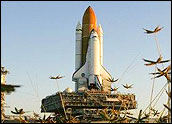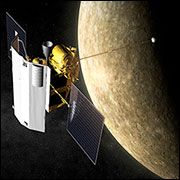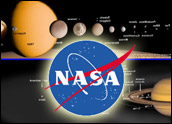
The need for more time to repair ominous-looking cracks in metal struts that support space shuttle Discovery’s hefty exterior fuel tanks prompted NASA officials Thursday to call for a launch delay, moving the flight from a previously planned early February date to that month’s end.
The delay, which follows a failed November launch attempt, has NASA engineers questioning potential manufacturing flaws as the crack-creating culprits.
Loaded with supplies for the International Space Station, Discovery is winding down NASA’s three decades in the shuttle business.
“NASA’s shuttle program is retiring,” NASA spokesperson Michael Curie told TechNewsWorld. “There are two final missions scheduled and one mission approved to fly, so the delay does not affect the schedule.”
To get the big bird flying on her symbolic swan song, “Discovery first needs to clear some basic safety inspections,” explained Lord Cole, an aerospace engineering doctoral student at the UCLA Energy and Propulsion Research Laboratory. “Right now, the damaged struts are leading to cracks in the space shuttle insulation,” which could portend more serious problems.
Fear of Foam
The space shuttle’s insulation has a deceptively soft name — “foam” — which belies its projectile potential. On liftoff and in flight, cracked foam insulation — a hard material, particularly in cold space — can break away, which “could lead to same catastrophe NASA had in 2003,” when a hunk of flying foam slammed into a wing, destroying the shuttle Columbia, Cole told TechNewsWorld.
Flying foam hastened the shuttle program’s end, “per the plan determined by the Bush administration following the Columbia accident,” NASA’s Curie said.
To insure safety and integrity, NASA isn’t taking any chances. Known as “stringers,” all 108 struts — most of which aren’t damaged — may have to be reinforced or replaced, NASA Kennedy Space Center news chief Allard Beutel said.
That solution strikes Stephen Braham, associate director and chief field engineer of the NASA Haughton-Mars Project, as a good idea.
“At this point, probably all the stringers will need to be beefed up before Discovery flies again,” he told TechNewsWorld. “More importantly, NASA will want to ensure it fully understands why this problem occurred.”
The repairs won’t be easy, so the extra time makes sense.
“It doesn’t help that the tank is so big,” said University of West Georgia emeritus physics professor Ben de Mayo, a Georgia Space Grant Consortium-NASA member. “To test the tank, they will probably have to fill it up with liquid oxygen and hydrogen.”
Future Flights
Given the present delays, “NASA will probably extend the number of shuttle missions,” de Mayo told TechNewsWorld.
However, the operative word is “probably,” with the “possibility of one extra mission dependent upon the length of the delays,” UCLA’s Cole added.
Tentatively scheduled to launch at summer’s end, Discovery’s final mission — the extra mission — “would still fall into the White House’s guidelines for shuttle retirement,” he said, “but only as long as the previous two launches are not severely delayed.”
Concerns about delays are justified and necessary, said Braham, who also directs Simon Fraser University’s PolyLAB.
“Delays cause worries due to cost increases and NASA’s generally fixed budget caps,” he said. “Congress required the mission to be flown only as long as it is safe.”
Future flights sans shuttles will involve “new programs, including a Commercial Transport Planning Office,” said NASA’s Beutel. “NASA is working with the FAA to develop private space flight guidelines that maintain our expectations for safe space flight, which is an inherently risky endeavor.”
Citing NASA’s current relationships with private contractors SpaceX and Orbital Sciences, which involve “oversight and investment,” Cole said that “because the Space Shuttle Program was such a large part of NASA and its public image, it will be interesting to see what direction they go after it ends.”
So far, the private commercial direction is “going extremely well,” Simon Fraser’s Braham said. “With the recent amazingly successful flight of the SpaceX Falcon 9, there is a lot of hope that Commercial Orbital Transportation Services will lead to commercial human flights to the International Space Station. This would create a new era for U.S. human space flight, and would be an excellent legacy for the Apollo and Shuttle programs.”






















































Sorry,but it these times the Space program is way less important now then it was when we were racing the Russian’s into space.
The Space Shuttle has lived long past its prime and needs to go out gracefully. I think in practical terms explorer space is pretty much a been there done that kind of thing now. Talking about going back to the Moon is just wasteful spending we can ill afford.